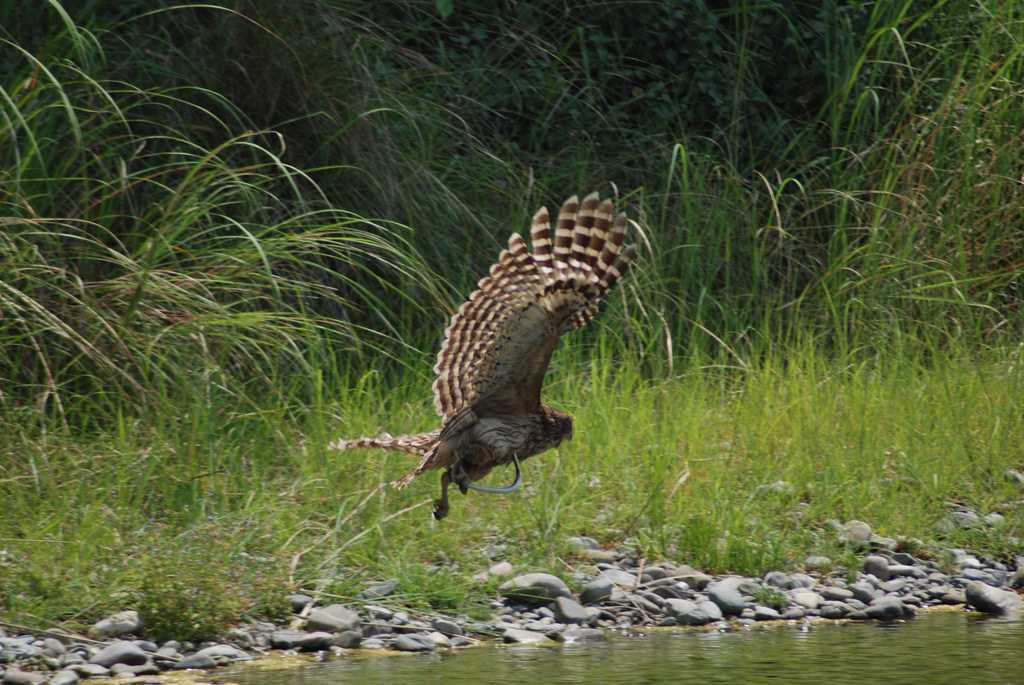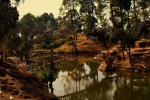Jim Corbett National Park Tourism
Ideal Duration : 1-2 days
Best Time : Mid October to Mid June
"The oldest National Park in India"
Jim Corbett National Park Tourism
Corbett National Park, set amidst the foothills of Himalayas, houses a variety of flora and fauna including rare ones such as tigers and is a treat for wildlife enthusiasts and photographers.
The oldest National Park in India, Jim Corbett National Park was established in 1936 as Hailey National Park and is home to the critically endangered species of the Royal Bengal Tiger. Located in the foothills of the Himalayas and along the banks of Ramaganga River, it is home to around 50 species of trees, 580 bird species and 50 species of animals along with 25 reptile species spread over an area of more than 500 sq km covering riverine belts, hills, marshy depressions, lakes, streams and grasslands. The Park is divided into 5 zones namely Bijrani, Dhikala,Jhirna, Domunda and Sonanandi and all of them have different gates. A visit to Corbett National Park is incomplete without a jungle safari, so make sure you go for a safari.
Download Jim Corbett National Park PDF Guide >
What's Great?
A beautiful place for one to visit to witness the beauty of flora and fauna at its zenith. One can spot rare tigers in the area. Also, its proximity to several major cities like Dehradun And Delhi help Corbett National Prak gather most of their tourists.
What's not so Great?
The resort is not open all throughout the year. The major parts of the resort are shut down in the monsoon months to help in the servicing and repairing of the roads of Jim Corbett. Also, the major stations and connecting nodes are all at least 50 km away, thus creating a bit hassle for the tourists.
For Whom
Families looking for a get-together, couples seeking a getaway, or just a bunch of keen youngsters wanting to witness the wildlife of the country, Jim Corbett satiates everyone's needs, thus ensuring no one is missed out on while visiting this place.
The Beautiful Home For The Wild
Being India's oldest and most prestigious national park established in 1936 as Hailey's National Park, Jim Corbett has ensured to maintain its legacy by retaining the richness of tigers in the region it is known for. Being one of the very few national parks to allow staying inside the premise at night, Jim Corbett is special in its own ways.
The landscape at Jim Corbett is incredibly diverse, ranging from marshy land to small hills, and lakes. Apart from tigers, it houses a wide variety of flora and fauna, including Otters and various type of fishes. It is advisable to roam around the park by renting a jeep, which is the comfortable option for the tourists. It also boasts of housing a variety of birds including migratory birds as well. The rich variety of Flora and Fauna is the major attraction for tourists coming to visit Jim Corbett.
The Zones Of The Park
The park is segregated into a few zones, all of which are explained.1. The first zone or the tourist zone is made to ensure travellers enjoy flora and fauna of the region. Visitors can roam by safari and enjoy his zone with close proximity to animals.2. Bijrani zone, located at 1 km distance from Ramnagar is a beautiful zone with loads of lush greenery.3. Open all throughout the year, Jhirna Safari Zone is located at a 16 km distance from Ramnagar.4. Dhela Safari Zone is the only zone in the buffer area open for tourists. The lush greenery and the rich biodiversity of this zone attracts a lot of attention of the tourists. Also, the distance between the zone and Ramnagar is approximately 13 km.5. Dhikala Zone is the richest zone in biodiversity, which is located 18 km away from Ramnagar. Plan a night stay in the zone to accentuate your adventures.6. Mainly known for bird watching, Durga Devi Zone is located at a 36 km distance from Ramnagar.
History of Corbett National Park
In as early as 1907, the British administration of colonial India came up with the idea of setting up a game reserve in this part of the country. Jim Corbett, the famous wildlife conservationist and author, assisted the British government in delimiting the area during the 1930s. In 1936, a wildlife reserve area known as Hailey National Park (covering an area of about 300 sq.km) was set up in this region. It was not before 1955-1956 that this reserve area was renamed as the Jim Corbett National Park, as a mark of tribute to Jim Corbett and his relentless service aimed towards the conservation of wildlife.
Jim Corbett National park was selected as the location to launch a prestigious wildlife conservation campaign - Project Tiger in 1974. The entire area of Sonandi Wildlife Sanctuary, under Kalagarh forest division, was added to its immediate boundary in 1991. This reserve is located in and administered from the district headquarters of Nainital in Uttarakhand.
Flora
A staggering 600 species of trees cover the gigantic area of about 521 sq.km under the Jim Corbett National Park, as per the Botanical Survey of India. The species include bamboo, shrubs, ferns, grass, climbers, trees to name a few.
This reserve is extremely blessed in terms of the diverse flora, which comprises both freshwater flora and alpine flora. Sal forests dominate Jim Corbett National Park, covering more than 75% of the reserve area.
Among the most dominant species in trees are Sal, Khair and Sisso. However, bamboo forests (led by Male Bamboo) too dominate some areas. The only conifer tree you will find is that of Chir Pine. Though a lot more species have contributed to the immense diversity of flora in this reserve, they are found but sparsely.
The mesmerizing and luscious green coverage of Jim Corbett is credited to the flowering trees which can be found in huge numbers. Some of the more prominent names include Kachnar (white tom pink flowers), Semal (huge red blossoms), ?flame of the forest?, Dhak(bright orange), etc.
Fauna
Jim Corbett has always been a favourable habitat for fauna, especially home to a significant population of endangered and critically endangered species of animal including Asiatic elephant and Ghariyal, respectively. The star attraction of this reserve that lures thousands of tourists throughout the year for an exciting jungle safari is the majestic Royal Bengal Tiger. However, other species like Asiatic Black Bear, Hog Deer, Walking Deer, Sambar, Sloth- to name a few also flock every nook and corner of Jim Corbett. The wildlife reserve serves as a paradise for bird lovers as an astounding 600 species of birds find a home in Jim Corbett. Great pied hornbill, white-backed vulture. Peacocks, Hodgson?s bushchat, orange breasted green pigeon, pallas fish eagle, golden oriole, fish owl, Indian Pitta are among the most prominent birds that can be found here. Apart from animals and birds, Jim Corbett National Park also houses endangered reptiles, Mugger Crocodiles, King Cobra, etc.
Wildlife Safari in Corbett National Park
To enjoy bird watching and sights of wild animals, especially tigers, wandering in the wild, the jungle safaris offer jeep rides through the terrain.
Read more aboutWildlife Safari in Corbett National Park
Itinerary
Jim Corbett being a national park, won't have a particular itinerary. One can take two days to explore the national park, and at the end of the first day, plan a night stay at Dhikala zone to make it an affair to remember. Plan the elephant ride and the jeep ride for your friends and family and roam around the beautiful national park, depicting the beauty and diversity of life in the country.
Mid Oct- Mid Junis the best time to visit Jim Corbett National Park
The moderate climate of Jim Corbett lets tourists explore the area all throughout the year, and makes the exploration a bit convenient and comfortable. Winters in the area are pleasant, and thus, can be enjoyed by everyone alike. Summers, though hot, are not uncomfortable. Monsoon can be a suitable pick to visit Jim Corbett, but the fact that a few parts of the park remain closed in this season will make the travel incomplete.
Weather in Jim Corbett National Park
Loading...
Jim Corbett National Park in Summer (March - May)
The temperature can extend up to 40 degrees Celcius during this time of the year in Jim Corbett. Considering the fact that there's presence of lush greenery in the area, the place still manages to remain cool and thus can be visited during summers. The humidity is really low and not at all uncomfortable, thus alluring tourists to visit this place during this season.
Jim Corbett National Park in Monsoon (June - August)
The place during monsoon is stunning and scenic. The spread of flora and the abundance of fauna in the region might be very alluring, but because some parts of the park remain closed during the monsoon, this time of the year is not considered as the best pick to pay a visit to Jim Corbett. The availability of off-season though can help you seal your deals at a bargain price during these months.
Jim Corbett National Park in Winter (October - February)
The place is beautiful with lush greenery spread all over post the monsoon season. Many birds and animals can be spotted in this season, and thus, it is one of the best picks to visit Jim Corbett. This season is the most preferred season out of all to visit Jim Corbett, as walking through the park becomes a pleasing experience with the subtle range of temperature and calm wintery breeze.
Monthly Weather in Jim Corbett National Park
Month
Avg. Minimum (°C)
Avg. Maximum (°C)
January
8
21
February
11
26
March
14
30
April
20
38
May
23
40
June
24
39
July
24
34
August
24
34
September
23
35
October
19
34
November
13
29
December
10
24
Events in Jim Corbett National Park
Tiger Spotting at Corbett-National-Park
December - May
The oldest tiger reserve in India, Corbett comprises marshes, hills, riverine belts and lakes. The best chance to get a spotting of the elusive Tiger is during winter months. You should avoid going during monsoons as most zones are closed, and even the ones which are open are subject to cancellation depending upon weather conditions.
Comments on Jim Corbett National Park
Post Your Comment


 Jungle Safari
Jungle Safari Corbett Waterfall
Corbett Waterfall River Rafting
River Rafting Elephant Ride in Corbett National Park
Elephant Ride in Corbett National Park Nainital
Nainital Lansdowne
Lansdowne Almora
Almora Auli
Auli Pauri Garhwal
Pauri Garhwal Rishikesh
Rishikesh